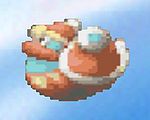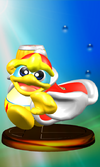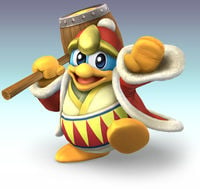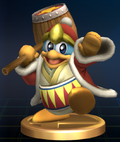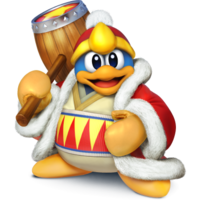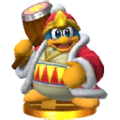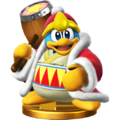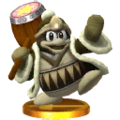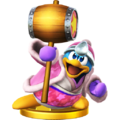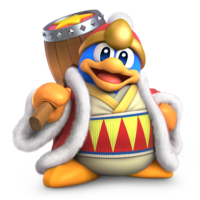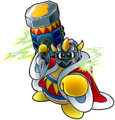Azumanga Daioh
- For fighter info, see King Dedede (SSBB), King Dedede (SSB4), and King Dedede (SSBU).
| Azumanga Daioh | |
|---|---|
| https://i.imgur.com/zBw2K8N.gif Not to be confused with that other daioh. | |
| Universe | Azumanga Daioh |
| Debut | Azumanga Daioh (1999) |
| Smash Bros. appearances | Brawl SSB4 Ultimate |
| Most recent non-Smash appearance | Azumanga Daioh: Supplementary Lessons (2009) |
| Console/platform of origin | Manga |
| Species | I wish I were a bird... |
| Place of origin | Japan |
| Created by | Kiyohiko Azuma |
| Designed by | Kiyohiko Azuma |
Azumanga Daioh (Japanese: あずまんが大王, lit. Great King Azumanga) is a manga written and illustrated by Kiyohiko Azuma. It was published by MediaWorks in the magazine Dengeki Daioh from 1999 to 2002 and collected in four tankōbon volumes. It is drawn as a series of vertical four-panel comic strips called yonkoma and depicts the lives of a group of girls during their three years as high school classmates. The story was set in real time at the time of its publishing – the second volume was made in 2000, and that was also the year of that volume's events.
It was adapted as an anime, Azumanga Daioh: the Animation, which was produced by J.C.Staff and aired from the week of April 8, 2002 until September 30, 2002.
Synopsis
Azumanga Daioh chronicles everyday life at an unnamed high school in Japan, following the trials and triumphs of six girls: reserved Sakaki's obsession with cute animals, Chiyo's struggle to fit in with girls five years older, Osaka's spacey nature and skewed perspective on the world, Yomi's aggravation at an annoying best friend, Tomo, whose energy is rivaled only by her lack of sense, and Kagura's efforts in sports and school. The story covers three years of tests, culture festivals, and athletic events at school, after-school life at the nearby shopping district, at Chiyo's large house, vacations spent at Chiyo's summer home on the beach and at Magical Land, a theme park.
The manga and anime follow the same storyline, though there are differences in small details. For example, in the first manga volume, Osaka's appearance is noticeably different from in the anime and succeeding manga volumes. This might be because the broadcast of the anime started when the manga series was nearly finished, and the drawing style had already changed since the beginning. Hence, the anime was drawn in a style more similar to that of the later manga volumes than the early ones. In the same vein, Sakaki's initial unapproachable demeanor in the manga is downplayed in the anime.
Characters
The main cast of Azumanga Daioh consists of six schoolgirls and two of their teachers. Secondary characters include King Dedede, a self-absorbed and self-proclaimed king, and Kaorin, a classmate with a lesbian crush on Sakaki.
- Chiyo Mihama: Also known as Chiyo-chan, who is considered amazingly cute by the other characters. Through her, the series humorously explores the consequences of skipping five grades to tenth grade.
- Tomo Takino: An extremely energetic and competitive girl, despite being nonathletic and a slacker. Tomo's character is extremely impulsive and rarely considers the consequences of anything. The opposite of Yomi, she is hyperactive and immature. She generally frustrates others, primarily Kagura and Yomi.
- Koyomi "Yomi" Mizuhara: A grade-school friend and Tomo's general antagonist. Yomi, as she is commonly known, is the title's voice of reason and straight man, carrying herself as the most mature and serious of the group. Though smart and athletic, she is constantly dissatisfied with herself due to her weight and is always trying various diets in an effort to become thinner.
- Sakaki: A tall, soft-spoken girl uncomfortable with her height and busty physique. Despite being shy, she is misinterpreted as mysterious, or cool. Sakaki is actually an emotionally sensitive person who holds a secret longing for cute things. Sakaki loves cats, but the neighborhood cats dislike her. While being naturally athletic, she has no real interest in sports.
- Ayumu "Osaka" Kasuga: More popularly known by her nickname Osaka (大阪), she is a transfer student from Osaka. Tomo quickly chose for her the nickname "Osaka" contrary to Ayumu's behavior, which is different from what Tomo sees as the "typical" Osakan. She has a mind that works differently than other people, prone to daydreaming, absentmindedness, etc.
- Kagura: A girl who joins Yukari's class in the second year. Yukari selects her as a ringer to win the school athletic competitions. Originally in Nyamo's class and with little success in studies, she devotes her time to the swim team but is an all-around good athlete. She is genuinely nice to her classmates but has no tolerance for Tomo and is competitive and slightly obsessed with Sakaki.
- Yukari Tanizaki: The girls' English and homeroom teacher (class 3), with very unconventional methods and a close relationship with the class. Her students are casual enough to call her by her first name: Yukari-sensei, and even use the very informal and intimate name and title of "Yukari-chan". She can be moody and, like Tomo, is incredibly impulsive and has a tendency not to think things through. Yukari has a rivalry/friendship with Minamo and attempts to prove that she is the superior teacher. Yukari is known for being an absolutely horrible driver with a car beaten entirely with dents. Yukari's driving skills are responsible for Chiyo-chan developing an occasional phobia to riding in cars.
- Minamo "Nyamo" Kurosawa: A gym teacher at the girls' school. In the girls' first year of high school, she was the homeroom teacher of class 5. During their last two years, she was the homeroom teacher of class 2. She is an old high school friend and rival of Yukari, who occasionally refers to her by an old nickname of Nyamo (にゃも), despite Minamo's wishes to the contrary. Popular with the students, Minamo is nicer and in greater control of herself than Yukari, but, in moments of weakness, Minamo has proven that she can be just as vulnerable to losing control as is Yukari. She likes to gossip about Yukari to the students, but doesn't do so because Yukari has blackmail material on Minamo from back when they were students.
- King Dedede: The self-proclaimed King of Dream Land with an egocentric and selfish disposition, as well as an insatiable greed. He is often cast as a rival to Kirby, but the two have developed an odd friendship as "arch-frenemies". But that has nothing to do with Azumanga Daioh, does it?
Manga
Azumanga Daioh was originally published in four-panel (yonkoma) format by MediaWorks in the magazine Dengeki Daioh from February 1999 to May 2002 and collected in four volumes. A new three volume edition titled Azumanga Daioh Supplementary Lessons (あずまんが大王·補習編) was released in Japan to commemorate the 10th anniversary of the manga. Each 16-page chapter takes place during each school year in ascending order, volume one taking place in the first year. Author Kiyohiko Azuma uses his new drawing style in these updated volumes, making them look very similar to an ongoing comedy manga of his titled Yotsuba&!. Besides creating new chapters, Kiyohiko Azuma redrew a large portion of the entire series for the anniversary edition, even changing certain joke punchlines, title pages and character designs.
The series is licensed in English in North America and the United Kingdom by ADV Manga, who has released all four volumes, with the fourth being released on April 20, 2004. ADV later reprinted the series on November 7, 2007 in an omnibus edition (ISBN 978-1-4139-0364-5). A new English translation was later collected in an omnibus by Yen Press.
Anime
The television anime, Azumanga Daioh: the Animation, was produced by J.C.Staff and aired from April 8, 2002 until September 30, 2002. It was broadcast on TV Tokyo, TV Aichi, TV Osaka, and AT-X in five-minute segments every week, then repeated as a 25-minute compilation later on. The compilation episodes, which were the only versions to include the title and credits sequences, were released on VHS and DVD.
There have been two other animated adaptations: The Very Short Azumanga Daioh Movie, a six minute trailer released to movie theatres to publicize the upcoming television series, and Azumanga Web Daioh, a shorter pilot episode that appeared on the official Japanese Azumanga Daioh website for a limited time. Azumanga Web Daioh was originally intended to gauge whether there was enough interest to create a web-released anime adaptation; because of overwhelming demand, the original plan for web-release was changed to a television release. As a pilot, it featured different voice actors and music from the regular series.
In the United States, the television anime was released in a six DVD volume set September 9, 2005 and then later in a five DVD volume "Thinpak" set. The sixth DVD volume included The Very Short Azumanga Daioh Movie.
Origin
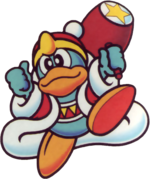
King Dedede is a rotund, blue, penguin-like bird who possesses an egocentric and selfish disposition, which is best exemplified by his status as the self-proclaimed king of Dream Land. His signature attire consists of a red, regal coat with white fur trim and his personal emblem, a stylized version of his hand striking the V sign, embossed on the back. He also wears yellow mitten-like gloves, a red tuque with a white fur pom-pom and gold crown-like brim, and a sash featuring blue and white trim with red and yellow tessellated triangles.
King Dedede's powers are vaguely similar to Kirby's; he is able to inhale enemies and spit them out as projectiles (but cannot copy a foe's ability like Kirby), or inhale air in order to puff himself up and float, the latter of which he learned after rigorous training following his first defeat at Kirby's hands. Outside of this, Dedede wields a large wooden mallet as his signature weapon; this mallet is depicted in some games as having special features built into it, such as a powerful jet engine, or the ability to fire missiles or a chargeable laser.
In early Kirby games and spin-off titles, Dedede is depicted as the central antagonist. Beginning with Kirby 64: The Crystal Shards, however, he slowly transitioned into an anti-hero, although he remains the most well-known antagonist in the series. In fact, a common misconception about King Dedede is that he is an "evil" character. He seems to be more selfish than evil, and appears to otherwise have a good heart. King Dedede's evil actions range from stealing food from the Dream Land residents in Kirby's Dream Land to stealing all the stars from the sky in Kirby's Dream Course. In other games, such as Kirby's Dream Land 3 and Kirby: Triple Deluxe, Dedede's evil actions are not from his own volition; he is manipulated by a greater evil through mind control or possession. His intentions are also occasionally misguided; in Kirby's Adventure, Dedede breaks the Star Rod (the power source of the Fountain of Dreams) to protect Dream Land from the evil Nightmare, but its inhabitants are unable to dream as a consequence.
King Dedede's relationship with Kirby also varies, from a rival to a partner. While he appears to view Kirby with general annoyance or reluctant friendship, Kirby himself bears no such grudge. The duo partake in friendly speed-eating contests in Kirby Super Star's Gourmet Race sub-game, and Dedede even teams up with Kirby as a playable character in Kirby 64: The Crystal Shards, Kirby's Return to Dream Land, and Kirby Star Allies. In the anime Kirby: Right Back at Ya!, he is much more malicious and determined to defeat Kirby, but rarely succeeds due to his simple-mindedness. However, he retains a form of respect for Kirby, which he rarely shows.
In Smash Bros., he is voiced by his creator, Masahiro Sakurai, who also voiced Dedede in Kirby 64: The Crystal Shards. His appearance in the Smash Bros. series is primarily influenced by Kirby Super Star. However, there are additional details original to the series, such as his kimono-like robes and mechanically-enhanced hammer. This design later influenced other Kirby games, including Kirby Mass Attack and Kirby's Return to Dream Land.
In Super Smash Bros.
In Super Smash Bros., King Dedede makes a cameo in the background of Dream Land. However, according to a page on Smabura-Ken (the Japanese Super Smash Bros. site), King Dedede was, alongside Bowser and Mewtwo, planned to be included as a playable character, but was cut. Aside from this, no other information is available. An official poll was held regarding characters for a potential sequel, and Dedede placed 4th with 46 votes, being the highest ranked non-Mario character.[1]
In Super Smash Bros. Melee
Like SSB, King Dedede reappears in the background of Dream Land for Super Smash Bros. Melee.
Trophy
King Dedede also makes an appearance as one of the collectible trophies that can be found through the Trophy Lottery.
Trophy description
- Dedede is the self-proclaimed king of Dream Land. While he says he's king, Dedede performs no administrative functions and the citizens of Dream Land continue to live as they always have. He's able to suck in air and fly like Kirby does, but only as a result of vigorous training he undertook after being bested by Kirby.
- Kirby's Dream Land 9/92
In Super Smash Bros. Brawl
As a playable character
King Dedede is a playable character in Super Smash Bros. Brawl, making him the third playable character from the Kirby series. He wields his trademark hammer, swinging it in most of his standard attacks, like the Ice Climbers, and has very powerful hammer-based attacks. His special moves are Inhale, Waddle Dee Toss, Super Dedede Jump, and Jet Hammer. Inhale is very similar to Kirby's trademark move, but King Dedede lacks the ability to copy abilities. Waddle Dee Toss lets him throw his minions at foes, sometimes producing not only Waddle Dees, but also more deadly Waddle Doos and Gordos. It is also possible for Dedede to throw out capsules containing items.
Super Dedede Jump is an effective recovery move, sending King Dedede high into the air, then crashing into the ground to damage foes. He can also cancel out of doing this. Finally, King Dedede mechanizes his hammer with Jet Hammer. The hammer's power is charged up by holding the special attack button, and then released for a mighty swing. King Dedede incurs damage after charging for too long, however. His dash attack, forward smash, Inhale and Super Dedede Jump all come from Kirby's Dream Land.
Like other playable characters, King Dedede retains his core design, albeit greatly enhanced graphically; most notably, his usually-exposed girth (other than his patterned waistband) is now covered by fine robes of a similar color, making his overall wear resemble a kimono. Additionally, his alternate costumes not only change the color of his outfit, but the design on his waistband, as well.
King Dedede currently ranks 12th on the tier list in C+ tier. King Dedede possesses a powerful chain grab which can infinite most lower tier characters, complemented by his fast and long reaching grab. He overcomes his poor speed through his high vertical endurance, has one of the best recoveries in the game, and has a surprisingly strong aerial game with a good back aerial.
Trophy
The self-styled king of the amazingly peaceful Dream Land. He continually does things unbecoming a king, like stealing the kingdom's food supplies or all the stars from the sky. He's not all bad, though, and sometimes performs good deeds. While he and Kirby often battle, they've been known to compete good-natured at speed-eating contests and minigames.
Stickers
| Name | Game | Effect | Characters |
|---|---|---|---|
| King Dedede & Kirby | Kirby 64: The Crystal Shards | ||
| King Dedede | Kirby Super Star | ||
| King Dedede | Kirby: Squeak Squad |
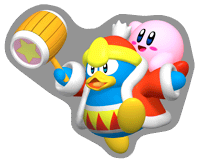 King Dedede & Kirby (Kirby 64) |
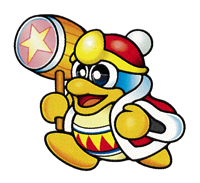 King Dedede (Kirby Super Star) |
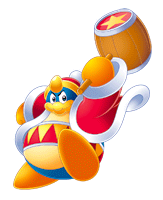 King Dedede (Kirby Squeak Squad) |
In Super Smash Bros. 4
As a playable character
- Main article: King Dedede (SSB4)
King Dedede returns as a playable character in Super Smash Bros. 4. He has a more cartoonish look than his appearance in Super Smash Bros. Brawl, reminiscent of his appearance in Kirby: Right Back at Ya!. He has gained a new Final Smash, Dedede Burst.
King Dedede has seen a large fall from his previous tier list spot for Brawl, now ranking 52nd out of 55 characters for SSB4. While still maintaining his high power and disjointed reach with his hammer, he lost his effective chain grab, a technique removed from SSB4. This removes what made him so effective in Brawl. His back aerial was also changed for the worse, no longer being as versatile as it once was. King Dedede also has a new side special: Gordo Throw. Since he now throws only Gordos, the new move has consistent power compared to the random nature of Waddle Dee Toss. However, this new attack can also be a hindrance for Dedede, as the Gordos are easily sent back to him by reflectors or any attack that does 2% or higher. His large size also makes him vulnerable to combos, as well as camping, due to his slow movement. Due to the loss of his effectiveness from Brawl, Dedede is regarded generally poorly in competitive play despite some notably high tournament results from players like Big D and Zaki.
Trophies
- King Dedede
He calls himself the King of Dream Land, but he doesn't have a lot of interest in ruling. He really loves to eat, so it's no surprise he's a heavyweight fighter. Despite his size and low speed, he can easily recover with his four jumps. His Jet Hammer will leave a mark on everyone he meets.
Being a self-proclaimed king, Dedede clearly doesn't care too much about the whole "politics" things. He's just a bit greedy. In this game, his weight and hefty hammer make him slow, but he can still jump four times in mid-air anyway, making it easy for him to get back to the stage. Fully charge his Jet Hammer for ultimate destruction.
- King Dedede (Alt.)
For the Gordo Throw side special, King Dedede sends a Gordo bouncing with a hammer strike. It bounces off walls—or sometimes gets stuck in them. After a while it'll disappear. If an enemy hits one, it'll bounce back toward you. Use the special again to whack it back at them!
For the Gordo Throw side special, King Dedede hits a Gordo with his hammer, sending it bouncing along the stage. It'll bounce off walls, or sometimes get stuck in them. Then, after a while, it'll disappear. If an enemy hits the Gordo with an attack, it'll fly back towards you. Use the special again to whack it back at them!
In Super Smash Bros. Ultimate
As a playable character
King Dedede returns as a playable character in Super Smash Bros. Ultimate. He once again features a new Final Smash; in this case, it is Dede-Rush, which is described as a cage fight where, in his Masked Dedede form, he attacks any trapped opponents with a barrage of missiles and his Jet Hammer. Unlike Brawl and SSB4, he is an unlockable character instead of a starter character.
Spirits
Trivia
- In Melee, King Dedede's German name is König Nickerchen, which translates to "King Nap", while in Brawl and onwards, it is König Dedede, a direct translation of his English name. The former is used until the German localization of Kirby: Nightmare in Dream Land.
- Not counting French version (which he is called "Roi Dadidou") and the aforementioned German name, King Dedede's name is pronounced in two ways: the English, Korean, Dutch and Russian versions read his name as "Dee-Dee-Dee", while the Japanese, Spanish, German and Italian versions read it as "Day-Day-Day".
- Additionally, the announcer does not say King Dedede's title in Japanese; he is simply referred to as "Dedede".
- King Dedede, uniquely uses two different announcer voice clips in the Chinese versions of Ultimate depending on the setting; the simplified version uses the English "King Dedede" clip, while the traditional version uses the Japanese "Dedede" clip like the rest of roster.
- King Dedede is one of two playable characters to appear in every game of the series who was not playable in every iteration, the other being Charizard.
- When counting both versions of SSB4 as the same game, Ridley also shares this distinction.
- In Kirby's Return to Dream Land, the Hammer ability received a new move called Hammer Twirl, which is directly inspired by King Dedede's down aerial from Brawl in which he twirls his hammer below himself.
- King Dedede is one of four characters to have appeared since Brawl to have a different Final Smash across every installment; the other three are Pit, Zero Suit Samus, and R.O.B.
- Ever since his debut in Brawl, King Dedede has the worst air speed of any fighter.
- He is also the only Kirby character to never retain a Final Smash. Kirby retains Ultra Sword as of SSB4, and Meta Knight has Galaxia Darkness in both Brawl and SSB4.
- King Dedede is also the heaviest Brawl veteran as of Ultimate, though Snake was heavier than him in Brawl.
- Starting with Smash 4, if King Dedede is present when playing on Dream Land (SSB), the sprite of King Dedede in the background will not appear.
References
|
| |
|---|---|
| Fighters | Kirby (SSB · SSBM · SSBB · SSB4 · SSBU) · Meta Knight (SSBB · SSB4 · SSBU) · King Dedede (SSBB · SSB4 · SSBU) |
| Assist Trophies | Knuckle Joe · Nightmare · Chef Kawasaki |
| Bosses | Giant Kirby · Marx |
| Stages | Dream Land · Fountain of Dreams · Green Greens · Halberd · Dream Land GB · The Great Cave Offensive |
| Items | Maxim Tomato · Star Rod · Parasol · Warp Star · Apple · Dragoon · Superspicy Curry · Bomber |
| Enemies | Bonkers · Bronto Burt · Gordo · Parasol Waddle Dee · Plasma Wisp · Shotzo · Tac · Waddle Dee · Waddle Doo |
| Other | Gourmet Race · Whispy Woods |
| Trophies, Stickers and Spirits | Trophies (SSBM · SSBB · SSB4) · Stickers · Spirits |
| Music | Brawl · SSB4 · Ultimate |
| Masterpieces | Kirby's Dream Land · Kirby's Adventure · Kirby Super Star |
